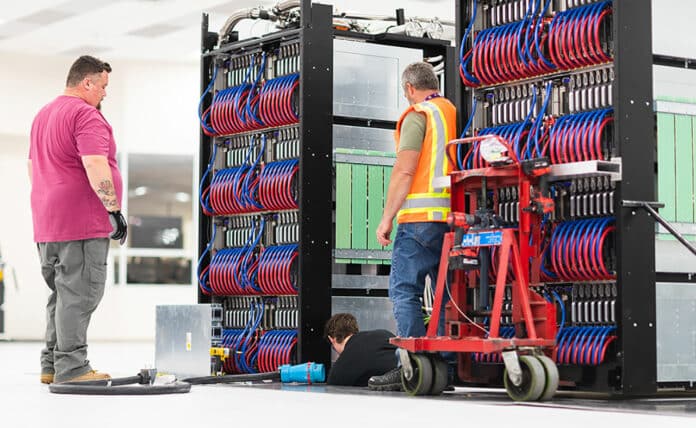Robust supercomputing capabilities are vital to assessing the health of the nation’s nuclear weapons stockpile. With modern experiments generating increasingly large data sets, it’s essential that scientists and engineers are able to compare these with simulation predictions to make informed decisions about the nation’s nuclear deterrent mission.
To analyze and interpret all this information, world-class computational models, platforms, and visualization capabilities are required, making it all the more important to have access to cutting-edge supercomputing technology.
To address this, the Los Alamos National Laboratory (LANL) is setting up Crossroads, its newest supercomputer that will provide leading-edge simulation capability in support of U.S. nuclear weapon stockpile stewardship. The Lab is rapidly advancing in the set-up of this powerful supercomputer.
The installation of Crossroads began in the first week of June this year, and roughly two weeks later, all the hardware necessary to assemble and install the system was in place.
The system has been supplied by Hewlett Packard Enterprise (HPE), which completed the connection of Crossroads to the Lab’s power and cooling distribution systems. The fiber optical cables were then tied into the high-performance computing (HPC) network at the Laboratory.
“Crossroads is emblematic of the future,” said Irene Qualters, associate Laboratory director for Simulation and Computation. “With the introduction of a key co-design element, high-bandwidth memory, Crossroads will deliver four to eight times better performance than Trinity on our most challenging stockpile simulation codes. And we expect additional performance and fidelity gains on future systems.”
Crossroads is the third supercomputer in the Advanced Technology Systems (ATS) deployed to help carry out these simulations. First, Los Alamos National Laboratory had Trinity (ATS-1) installed in 2015, which boasted a computing prowess of 41.46 petaFLOPS. Sierra (ATS-2) was at Lawrence Livermore National Laboratory. Crossroads (ATS-3) is now at Los Alamos.
Eventually, El Capitan (ATS-4) will be at Lawrence Livermore, and a forthcoming ATS-5 – still unnamed – will be sited at Los Alamos.
Early tests have indicated that Crossroads can be expected to deliver a four to eight-times improvement in overall efficiency over Trinity. This is made possible by high-bandwidth memory that brings memory directly to the processing chip and allows for quicker “talking” between the CPU and the memory.
“It hardly ever happens in computing that you can move to a new system and see huge gains without changing the codes,” said Grider in a statement. “But the switch from Trinity to Crossroads will do just that.”
Crossroads also comprises three smaller ancillary subsystems, Rocinante, Razorback, and Tycho, each tasked to perform a particular function. Because code developers do some of their work in an unclassified environment, a “mini-me” version of Crossroads with the same architecture is a key component. It allows users to develop codes and work in an open environment. Rocinante serves that purpose to support Crossroads.
Razorback, which regular users can’t access, is an even smaller-scale version of the system that admins use to prepare and test upgrades, patches, and other changes before applying them to the larger machines. Finally, there’s Tycho, which had almost the same architecture as Crossroads but featured a more conventional memory. This provides cycles to stockpile simulation users who otherwise might have been waiting on Crossroads.
Currently, Lab crews and HPE are running initial diagnostics for the entire Crossroads system, which is expected to be available to users at three National Nuclear Security Administration (NNSA) labs this fall.
Although Crossroads is currently in the process of being installed, HPC has been making plans for the eventual deployment of the as-of-yet unnamed ATS-5 system for the past couple of years.
